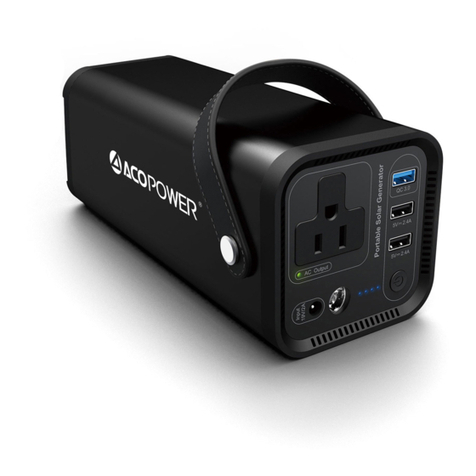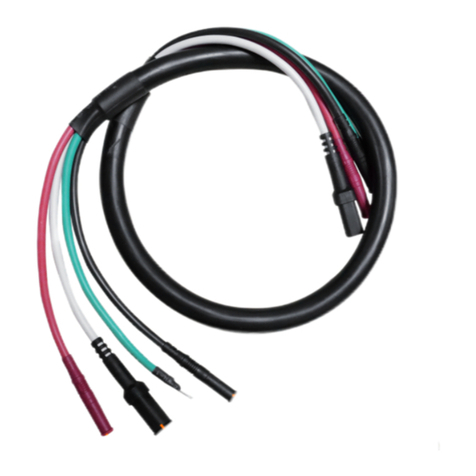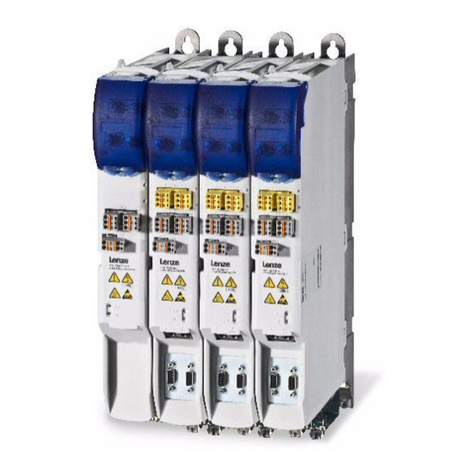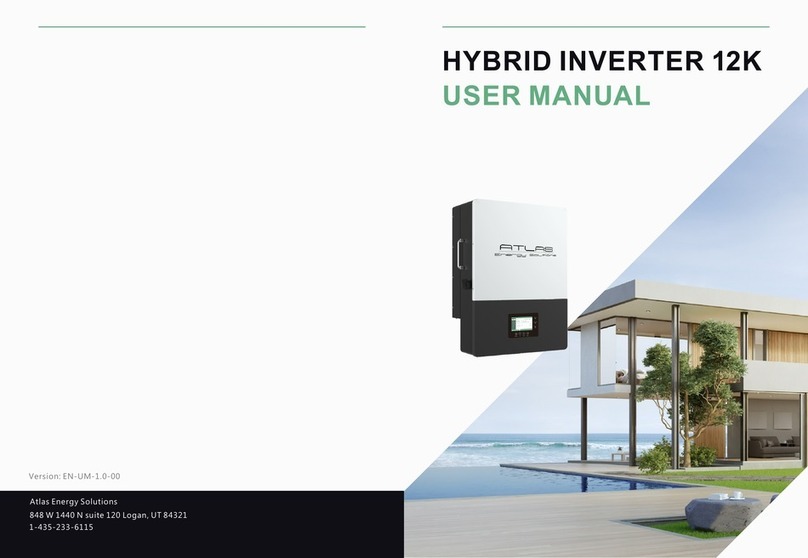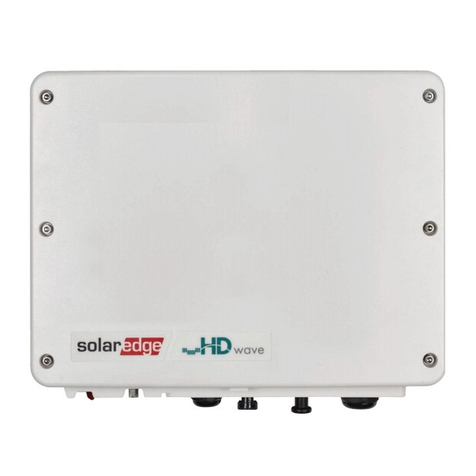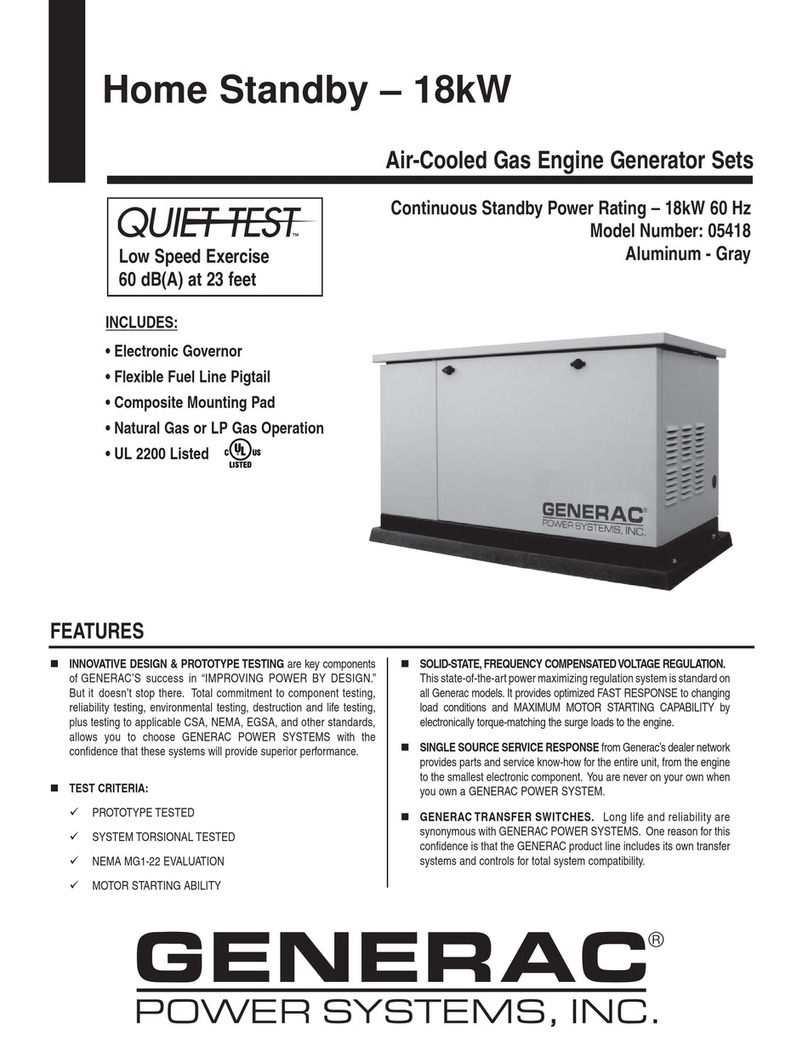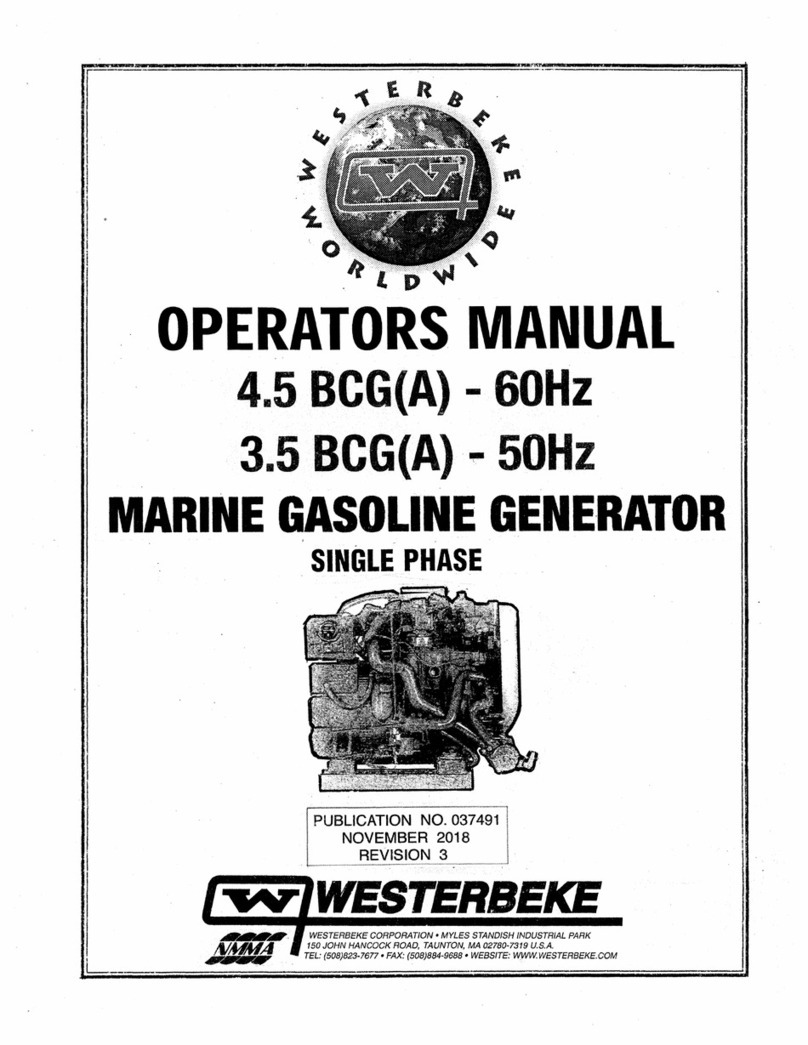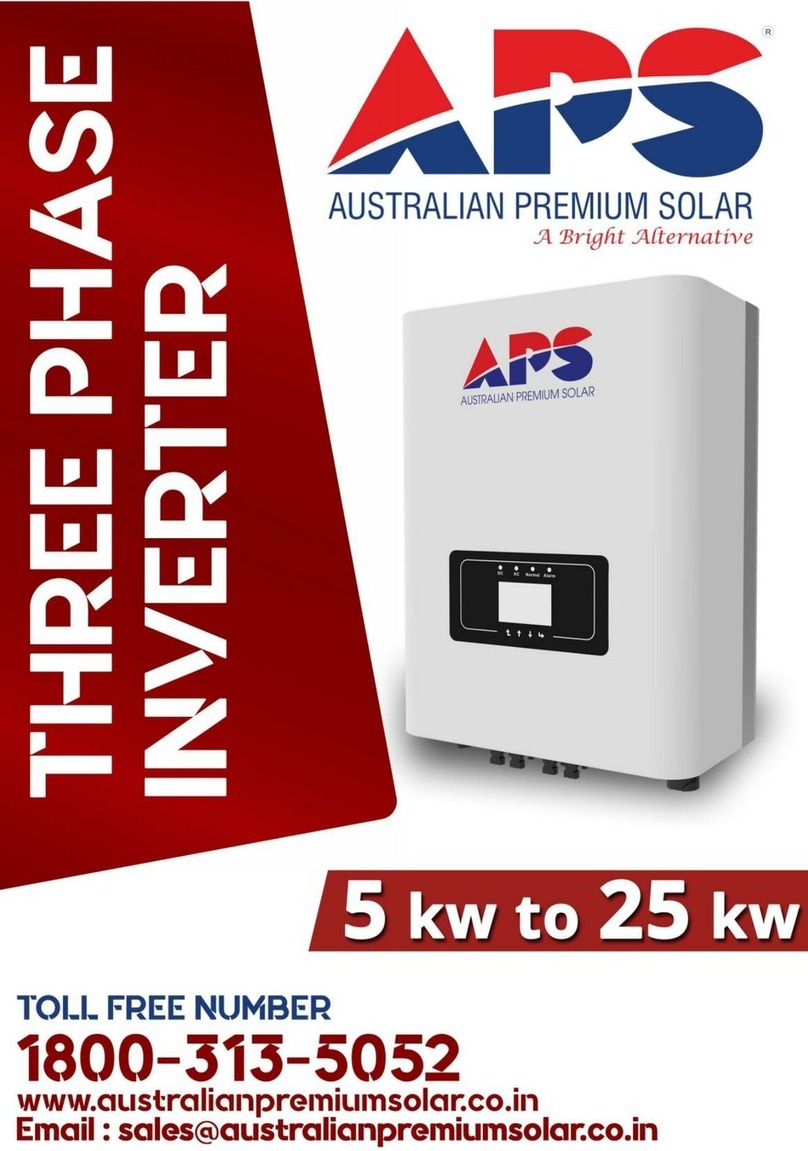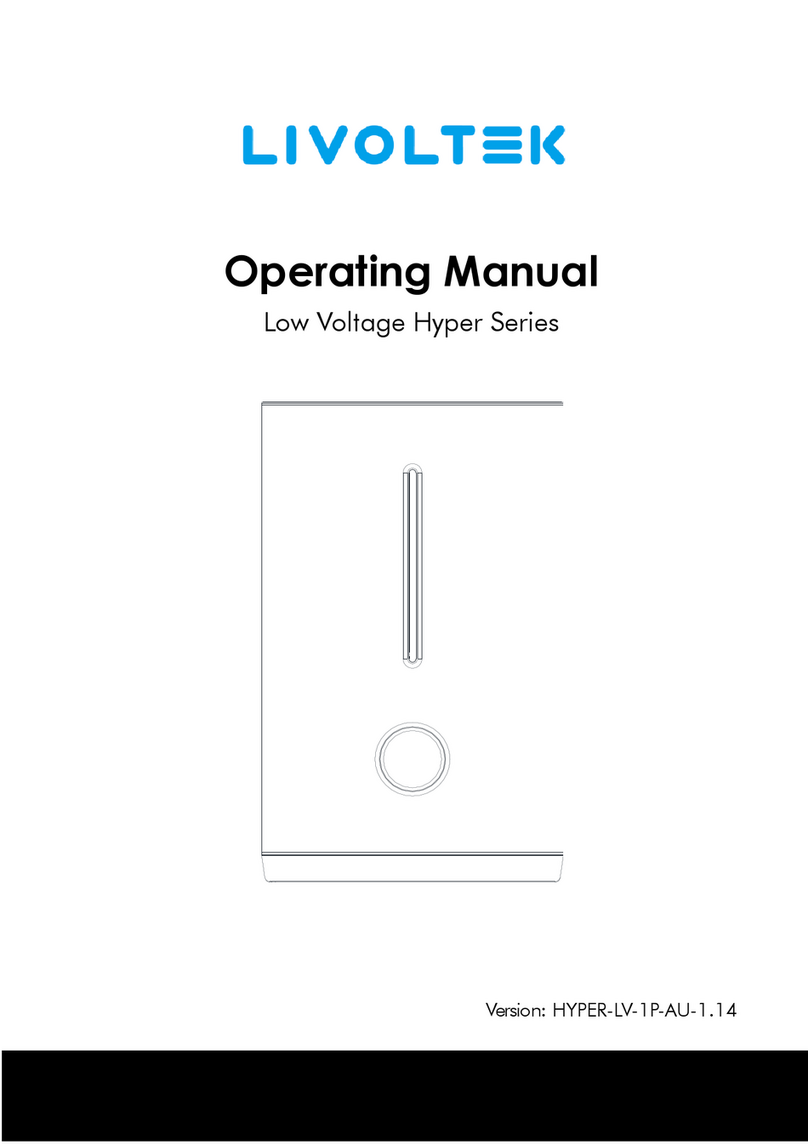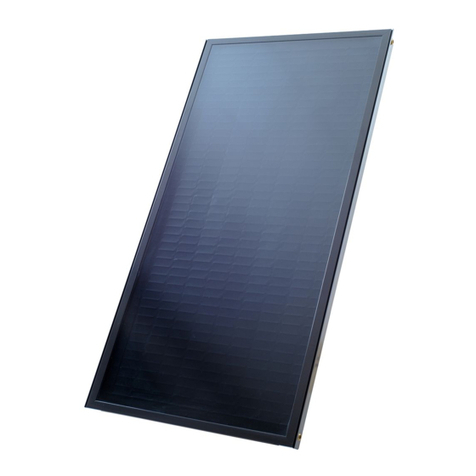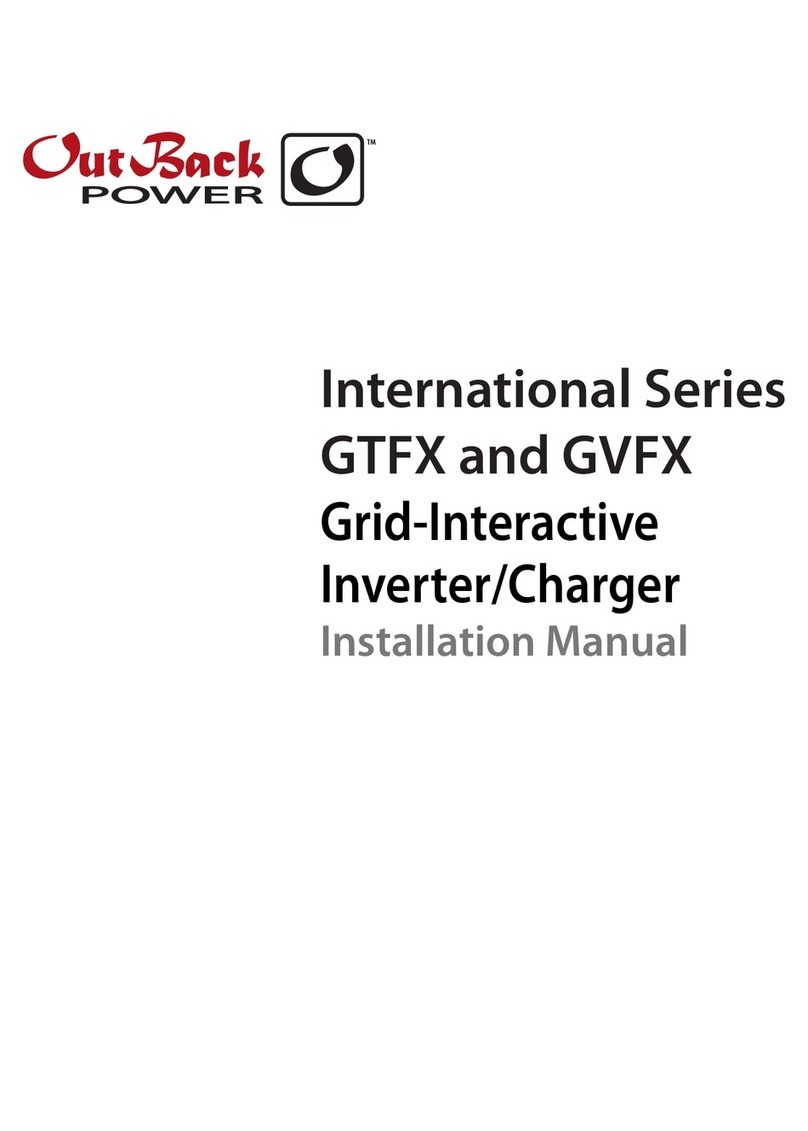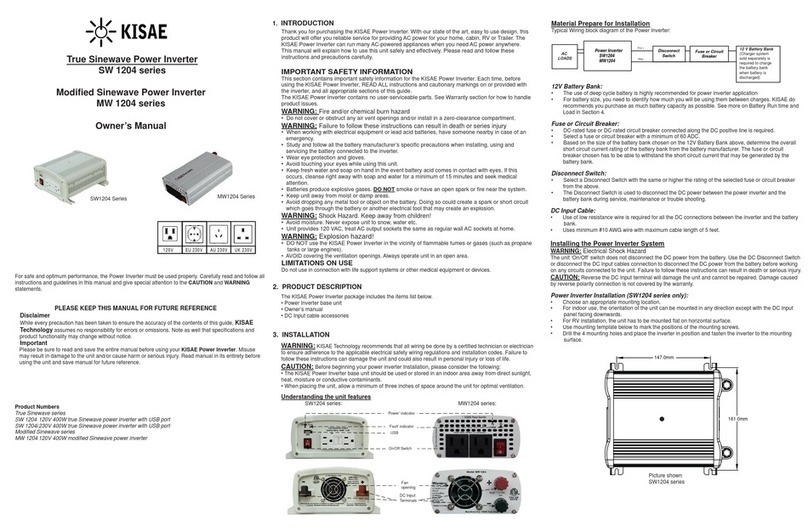ACOPOWER Midas Y Series User manual

Midas Y Series
User Manual
MPPT Solar Charge Controller
Models:MY20/MY30/MY40
Add: 4120 Valley Blvd, Walnut, CA 91789,USA
Tel: 1.626.575.7722 Email:sales@acopower.com Web:www.acopower.com
01 02 03 04 05 06 07
08 09 10 11 12 13 14 15 16 17
18 19 20 21 22 23 24 25 26 27
28 29 30 31 32 33 34 35 36

Important Safety Instructions
Please keep this manual for future review.
This manual contains all instructions of safety, installation and operation for Midas
Y series Maximum Power Point Tracking (MPPT) controller ("the controller" as
referred to in this manual).
General Safety Information
Read carefully all the instructions and warnings in the manual before
installation.
No user serviceable components inside the controller. DO NOT disassemble or
attempt to repair the controller.
Mount the controller indoors. Avoid exposure the components and do not allow
water to enter the controller.
Install the controller in a well ventilated place. The controller’s heat sink may
become very hot during operation.
Suggest installing appropriate external fuses/breakers.
Make sure to switch off all PV array connections and the battery fuse/breakers
before controller installation and adjustment.
Power connections must remain tight to avoid excessive heating from loose
connection.
01 02 03 04 05 06 07
08 09 10 11 12 13 14 15 16 17
18 19 20 21 22 23 24 25 26 27
28 29 30 31 32 33 34 35 36

01 02 03 04 05 06 07
08 09 10 11 12 13 14 15 16 17
18 19 20 21 22 23 24 25 26 27
28 29 30 31 32 33 34 35 36
CONTENTS
1. General Information
1.1 Overview
1.2 Characteristics
1.3 Product Classification
2. Installation Instructions
2.1 General Installation Notes
2.2 PV Array Requirements
2.3 Wire Size
2.4 Mounting
3. Adanced Display unit
4. Control Parameters Setting
4.1 Battery types
4.1.1 Support battery types
4.1.2 Battery Voltage Control Parameters
4.1.3 Settings
4.2 Load working modes
4.2.1 LCD setting
4.2.2 R485 communication setting
4.3 Accessories (optional)
5. Protections, Troubleshooting and Maintenance
5.1 Protection
5.2 Troubleshooting
5.3 Maintenance
6. Technical Specifications
Annex I Conversion Efficiency Curves
Annex II Mechanical Dimension Diagram
01
01
02
03
03
03
04
05
07
11
16
16
16
17
19
20
20
21
23
24
24
27
28
29
31
34

1. General Information
1.1 Overview
Midas Y series controller adopt the advanced MPPT control algorithm, it can
minimize the maximum power point loss rate and loss time, quickly track the
maximum power point(MPP) of the PV array and obtain the maximum energy from
solar array under any conditions; and it can increase the ratio of energy utilization
in the solar system by 20%-30% compared with PWM charging method.
Limiting the charging power & current and reducing charging power functions
ensure the system stable with over PV modules in high temperature environment.
IP33 Ingress protection and isolated RS485 design further improve the controller’s
reliability and meet the different application requirements.
Midas Y series controller owns self-adaptive three-stage charging mode based on
digital control circuit, which can effectively prolong the lifespan of battery and
significantly improve the system performance. It also has comprehensive electronic
protection for overcharge, overdischarge, PV & battery reverse polarity etc, to
ensure the solar system more reliable and more durable. This controller can be
widely used for RV, household system, field monitoring and many other applications.
CE certification(LVD EN/IEC62109,EMC EN61000-6-1/3)
100% charging and discharging in working environment temperature range
High quality and low failure rate components of ST or IR to ensure service life
Advanced MPPT technology & ultra-fast tracking speed guarantee tracking
efficiency up to 99.5%
Maximum DC/DC transfer efficiency is as high as 98.5%★, full load efficiency is
up to 97.2%★
Advanced MPPT control algorithm to minimize the MPP lost rate and lost time
Accurate recognizing and tracking of multi-peaks maximum power point
Wide MPP operating voltage range
Support the lead-acid and lithium batteries, programmable temperature
compensation
Limit charging power & current over rated value
Real-time energy statistics functiont
Power reduction automatically over temperature value
Multiple load work modes
Comprehensive electronic protection
Features:
01 02 03 04 05 06 07
08 09 10 11 12 13 14 15 16 17
18 19 20 21 22 23 24 25 26 27
28 29 30 31 32 33 34 35 36
1. General Information
1.1 Overview
1.2 Characteristics
1.3 Product Classification
2. Installation Instructions
2.1 General Installation Notes
2.2 PV Array Requirements
2.3 Wire Size
2.4 Mounting
3. Adanced Display unit
4. Control Parameters Setting
4.1 Battery types
4.1.1 Support battery types
4.1.2 Battery Voltage Control Parameters
4.1.3 Settings
4.2 Load working modes
4.2.1 LCD setting
4.2.2 R485 communication setting
4.3 Accessories (optional)
5. Protections, Troubleshooting and Maintenance
5.1 Protection
5.2 Troubleshooting
5.3 Maintenance
6. Technical Specifications
Annex I Conversion Efficiency Curves
Annex II Mechanical Dimension Diagram

Isolated RS485 with 5V/200mA protected output for no power devices, with
Modbus protocol
Support monitoring and setting the parameters via APP or PC software
IP33▲Ingress protection
1.2 Characteristics
Figure 1 Product Characteristics
1
1
2
2
3
3
4
4
5
5
6
6
7
7
8
8
RTS port
PV Terminals
Battery Terminals
Load Terminals
★RS485 communication port
Terminal protection cover
Display units
Mounting Hole Φ5mm
★If the temperature sensor is short circuit or damaged, the controller will charge
or discharge according the voltage setting point at the default temperature setting
of 25 ºC(no temperature compensation).
01 02 03 04 05 06 07
08 09 10 11 12 13 14 15 16 17
18 19 20 21 22 23 24 25 26 27
28 29 30 31 32 33 34 35 36

1.3 Product Classification
Model Picture Display
MY20
MY30
MY40
LED Indicators: PV & battery & load working status
Buttons: View or set the parameters or clear the error information.
LCD: PV display: voltage/current /generated energy/power
Battery display: voltage/current/temperature/capacity
Load display: voltage/current/power/consumed energy/load
working mode.
Please read the entire installation instructions to get familiar with the installation
steps before installation.
Be very careful when installing the batteries, especially flooded lead-acid battery.
Please wear eye protection, and have fresh water available to wash and clean
any contact with battery acid.
Keep the battery away from any metal objects, which may cause short circuit of
the battery.
Explosive battery gases may come out from the battery during charging, so
make sure ventilation condition is good.
Ventilation is highly recommended if mounted in an enclosure. Never install the
controller in a sealed enclosure with flooded batteries! Battery fumes from
vented batteries will corrode and destroy the controller circuits.
Loose power connections and corroded wires may result in high heat that can
melt wire insulation, burn surrounding materials, or even cause fire. Ensure tight
connections and use cable clamps to secure cables and prevent them from
swaying in mobile applications.
The controller can work with lead-acid battery and lithium battery within its
control scope.
Battery connection may be wired to one battery or a bank of batteries. The
following instructions refer to a singular battery, but it is implied that the battery
connection can be made to either one battery or a group of batteries in a battery
bank.
Multiple same models of controllers can be installed in parallel on the same
battery bank to achieve higher charging current. Each controller must have its
own solar module(s).
2. Installation Instructions
2.1 General Installation Notes
01 02 03 04 05 06 07
08 09 10 11 12 13 14 15 16 17
18 19 20 21 22 23 24 25 26 27
28 29 30 31 32 33 34 35 36

(1) Serial connection (string) of PV modules
As the core component of solar system, controller could be suitable for various
types of PV modules and maximize converting solar energy into electrical energy.
According to the open circuit voltage (Voc) and the maximum power point voltage
(VMpp) of the MPPT controller, the series number of different types PV modules
can be calculated. The below table is for reference only.
Select the system cables according to 5A/mm2 or less current density in
accordance with Article 690 of the National Electrical Code, NFPA 70.
MY20/MY30/MY40:
12V 4 2 2 1 2 1 2 1
24V 4 3 2 2 2 2 2 2
36 cell
Voc<23V
48 cell
Voc<31V
54 cell
Voc<34V
60 cell
Voc<38V
Max Best Max Best Max Best Max Best
System
voltage
12V 2 1 1 1 1
24V 2 1 1 1 1
72 cell Voc<46V 96 cell Voc<62V
Max Best Max Best
System
voltage
Thin-Film Module
Voc>80V
NOTE: The above parameter values are calculated under standard test conditions
(STC (Standard Test Condition):Irradiance 1000W/m2,Module Temperature 25
℃,Air Mass1.5.)
01 02 03 04 05 06 07
08 09 10 11 12 13 14 15 16 17
18 19 20 21 22 23 24 25 26 27
28 29 30 31 32 33 34 35 36
(2) Maximum PV array power
The MPPT controller has the function of charging current/power-limiting, that is,
during the charging process, when the charging current or power exceeds the
rated charging current or power, the controller will automatically limit the
charging current or power to the rated range, which can effectively protect the
charging parts of controller, and prevent damages to the controller due to the
connection of some over-specification PV modules. The actual operation of PV
array is as follows:
2.2 PV Array Requirements

Condition 1:
Actual charging power of PV array ≤ Rated charging power of controller
Condition 2:
Actual charging current of PV array ≤ Rated charging current of controller
When the controller operates under “Condition 1”or“Condition 2”, it will carry out
the charging as per the actual current or power; at this time, the controller can work
at the maximum power point of PV array.
WARNING: When the power of PV is not greater than the rated
charging power, but the maximum open-circuit voltage of PV array is
more than 100V (at the lowest environmental temperature), the
controller may be damaged.
Condition 3:
Actual charging power of PV array>Rated charging power of controller
Condition 4:
Actual charging current of PV array>Rated charging current of controller
When the controller operates under “Condition 3”or“Condition 4”,it will carry out
the charging as per the rated current or power.
WARNING: When the power of PV module is greater than the rated
charging power, and the maximum open-circuit voltage of PV array is
more than 100V (at the lowest environmental temperature), the
controller may be damaged.
According to “Peak Sun Hours diagram”, if the power of PV array exceeds the rated
charging power of controller, then the charging time as per the rated power will be
prolonged, so that more energy can be obtained for charging the battery. However,
in the practical application, the maximum power of PV array shall be not greater
than 1.5 x the rated charging power of controller. If the maximum power of PV
array exceeds the rated charging power of controller too much, it will not only
cause the waste of PV modules, but also increase the open-circuit voltage of PV
array due to the influence of environmental temperature, which may make the
probability of damage to the controller rise. Therefore, it is very important to
configure the system reasonably. For the recommended maximum power of PV
array for this controller, please refer to the table below:
01 02 03 04 05 06 07
08 09 10 11 12 13 14 15 16 17
18 19 20 21 22 23 24 25 26 27
28 29 30 31 32 33 34 35 36

Model
Rated Charge
Current
Rated Charge
Power
Max. PV Array
Power
Max. PV open circuit
voltage
MY20
MY30
MY40
260W/12V
520W/24V
390W/12V
780W/24V
520W/12V
1040W/24V
390W/12V
780W/24V
580W/12V
1170W/24V
780W/12V
1560W/24V
20A
30A
40A
92V
100V
①
②
① At 25℃environment temperature
② At minimum operating environment temperature
2.3 Wire Size
The wiring and installation methods must conform to all national and local electrical
code requirements.
PV Wire Size
Since PV array output can vary due to the PV module size, connection method or
sunlight angle, the minimum wire size can be calculated by the Isc* of PV array.
Please refer to the value of Isc in the PV module specification. When PV modules
connect in series, the Isc is equal to a PV modules Isc. When PV modules connect in
parallel, the Isc is equal to the sum of the PV modules’Isc. The Isc of the PV array
must not exceed the controller’s maximum PV input current. Please refer to the
table as below:
NOTE: All PV modules in a given array are assumed to be identical.
*Isc=short circuit current(amps) Voc=open circuit voltage.
Model Max. PV input current Max. PV wire size*
MY20
MY30
MY40
20A
30A
40A
6mm /10AWG
10mm /8AWG
16mm /6AWG
2
2
2
*These are the maximum wire sizes that will fit the controller terminals.
CAUTION: When the PV modules connect in series, the open circuit
voltage of the PV array must not exceed 92V at 25℃environment
temperature.
01 02 03 04 05 06 07
08 09 10 11 12 13 14 15 16 17
18 19 20 21 22 23 24 25 26 27
28 29 30 31 32 33 34 35 36

Battery and Load Wire Size
The battery and load wire size must conform to the rated current, the reference
size as below:
Model
Rated Charge
Current
Rated discharge
current Battery wire size Load wire
size
MY20
MY30
MY40
20A
30A
40A
20A
30A
40A
6mm /10AWG
10mm /8AWG
16mm /6AWG
2
2
2
6mm /10AWG
10mm /8AWG
16mm /6AWG
2
2
2
CAUTION: The wire size is only for reference. If there is a long distance
between the PV array and the controller or between the controller and
the battery, larger wires can be used to reduce the voltage drop and
improve performance.
CAUTION: For the battery, the recommended wire will be selected
according to the conditions that its terminals are not connected to any
additional inverter.
2.4 Mounting
WARNING: Risk of explosion! Never install the controller in a sealed
enclose with flooded batteries! Do not install in a confined area where
battery gas can accumulate.
WARNING: Risk of electric shock! When wiring the solar modules, the
PV array can produce a high open circuit voltage, so turn off the
breaker before wiring and be careful when wiring.
CAUTION:The controller requires at least 150mm of clearance above
and below for proper air flow. Ventilation is highly recommended if
mounted in an enclosure.
01 02 03 04 05 06 07
08 09 10 11 12 13 14 15 16 17
18 19 20 21 22 23 24 25 26 27
28 29 30 31 32 33 34 35 36

Installation Procedure:
Mounting Instruction
Figure 2-1 Mounting
150mm
150mm 150mm
150mm
01 02 03 04 05 06 07
08 09 10 11 12 13 14 15 16 17
18 19 20 21 22 23 24 25 26 27
28 29 30 31 32 33 34 35 36

Step 1: Determination of Installation Location and Heat-dissipation Space
Determination of installation location: The controller shall be installed in a place
with sufficient air flow through the radiators of the controller and a minimum
clearance of 150 mm from the upper and lower edges of the controller to ensure
natural thermal convection. Please see Figure 2-1: Mounting
CAUTION: If the controller is to be installed in an enclosed box, it is
important to ensure reliable heat dissipation through the box.
Figure 2-2 Schematic of wiring diagram
Step 2:Connect the system in the order of battery load PV array
in accordance with Figure 2-2,”Schematic Wiring Diagram” and disconnect the
system in the reverse order .
1
1
1
2
2
2
3
3
3
CAUTION: While wiring the controller do not close the circuit breaker or
fuse and make sure that the leads of "+" and "-" poles are connected
correctly.
CAUTION: A fuse which current is 1.25 to 2 times the rated current of the
controller, must be installed on the battery side with a distance from the
battery not greater than 150 mm.
CAUTION: If the controller is to be used in an area with frequent lightning
strikes or unattended area, it must install an external surge arrester.
01 02 03 04 05 06 07
08 09 10 11 12 13 14 15 16 17
18 19 20 21 22 23 24 25 26 27
28 29 30 31 32 33 34 35 36

CAUTION: If an inverter is to be connected to the system, connect the
inverter directly to the battery, not to the load side of the controller.
Step 3:Grounding
Midas Y series is a common-negative controller, where all the negative terminals of
PV array, battery and load can be grounded simultaneously or any one of them will
be grounded. However, according to the practical application, all the negative
terminals of PV array, battery and load can also be ungrounded, but the grounding
terminal on its shell must be grounded, which may effectively shield the electro-
magnetic interference from the outside, and prevent some electric shock to human
body due to the electrification of the shell.
CAUTION: For common-negative system, such as motorhome, it is
recommended to use a common-negative controller; but if in the
common-negative system, some common-positive equipment are used,
and the positive electrode is grounded, the controller may be damaged.
Step 4:Connect accessories
Connect the remote temperature sensor cable
Temperature Sensor Remote Temperature Sensor
Cable (Optional)
Connect the remote temperature sensor cable to the interface ①and place the
other end close to the battery.
CAUTION: If the remote temperature sensor is not connected to the
controller,, the default setting for battery charging or discharging
temperature is 25 °C without temperature compensation.
Connect the accessories for RS485 communication
Refer to chaper4 “Control Parameters Setting”.
Step 5:Powered on the controller
Closing the battery fuse will switch on the controller. Then check the status of the
battery indicator (the controller is operating normally when the indicator is lit in
green). Close the fuse and circuit breaker of the load and PV array. Then the system
will be operating in the preprogrammed mode.
CAUTION: If the controller is not operating properly or the battery
indicator on the controller shows an abnormality, please refer to 5.2
“Troubleshooting”
01 02 03 04 05 06 07
08 09 10 11 12 13 14 15 16 17
18 19 20 21 22 23 24 25 26 27
28 29 30 31 32 33 34 35 36

3. Adanced Display unit
(1) Indicator
Green
Green
Green
Green
Green
Green
Green
Orange
Indicator Color Status Instruction
On Solid
OFF
Slowly Flashing(1Hz)
Fast Flashing(4Hz)
PV connection normal but low
voltage(low irradiance) from
PV, no charging
No PV voltage(night time) or
PV connection problem
In charging
PV Over voltage
On Solid
On Solid
Slowly Flashing(1Hz)
Fast Flashing(4Hz)
Normal
Full
Over voltage
Under voltage
01 02 03 04 05 06 07
08 09 10 11 12 13 14 15 16 17
18 19 20 21 22 23 24 25 26 27
28 29 30 31 32 33 34 35 36

Red
Red
Yellow
Yellow
Indicator Color Status Instruction
On Solid
Slowly Flashing(1Hz)
Over discharged
Battery Overheating
Lithium battery Low tempera-
ture①
On Solid
OFF
Load ON
Load OFF
PV&BATTLED fast flashing
Controller Overheating
System voltage error②
① When a lead-acid battery is used, the controller doesn’t have the low temperature
protection.
② When a lithium battery is used, the system voltage can’t be identified
automatically
(2) Button
Press the button
Press the button and
hold 5s
PV browsing interface
Setting data +
Setting the LCD cycle time
Press the button
BATT browsing interface
Cursor displacement during setting
Press the button and
hold 5s
Setting the battery type, battery
capacity level and temperature unit.
PV
BATT
01 02 03 04 05 06 07
08 09 10 11 12 13 14 15 16 17
18 19 20 21 22 23 24 25 26 27
28 29 30 31 32 33 34 35 36

Press the button
Press the button and
hold 5s
Controller load browsing interface
Setting data -
Setting the load working mode
Press the button
Enter into setting interface
Setting interface switch to the
browsing interface
Press the button Exit the setting interface
Setting parameter as enter button
(3) Display
Icon Information Icon Information Icon Information
Icon Information Icon Information Icon Information
Day Not charging Not discharging
Night Charging Discharging
LOAD
ESC
SET
01 02 03 04 05 06 07
08 09 10 11 12 13 14 15 16 17
18 19 20 21 22 23 24 25 26 27
28 29 30 31 32 33 34 35 36

1) PV parameters
Display:Voltage/Current/Temperature/Battery capacity level
2) Battery parameters
Display:Voltage/Current/Temperature/Battery capacity level
3)Load parameters
Display:Voltage/Current/Power/ Consumed energy/Load working mode-Timer1/
Load working mode-Timer2
(4)Setting parameters
1)Battery type
Sealed (Default) Gel Flooded User
01 02 03 04 05 06 07
08 09 10 11 12 13 14 15 16 17
18 19 20 21 22 23 24 25 26 27
28 29 30 31 32 33 34 35 36

Operation:
Step 1: Press the button for the setting interface.
Step 2: Press the button and hold 5s for the battery type interface.
Step 3: Press the or button to choose the battery type.
Step 4: Press the button to confirm the battery type.
CAUTION:Please refer to chapter 4.1 for the battery control voltage
setting, when the battery type is User.
2)Battery capacity
Operation:
Step 1: Press the button for the setting interface.
Step 2: Press the button and hold 5s for the battery type interface.
Step 3: Press the button for the battery capacity interface.
Step 4: Press the or button to set the battery capacity.
Step 5: Press the button to confirm the parameters.
3) Temperature units
Operation:
Step 1: Press the button for the setting interface.
Step 2: Press the button and hold 5s for the battery type interface.
Step 3: Press the button twice for the temperature unit interface.
Step 4: Press the or button to set the temperature units.
Step 5: Press the button to confirm the parameters.
BATT
PV
PV
LOAD
LOAD
SET
BATT
SET
SET
SET
PV LOAD
BATT
SET
SET
SET
SET
01 02 03 04 05 06 07
08 09 10 11 12 13 14 15 16 17
18 19 20 21 22 23 24 25 26 27
28 29 30 31 32 33 34 35 36

4) LCD cycle time
NOTE: The LCD cycle default time is 2s,the setting time range is 0~20s.
Operation:
Step 1: Press the button for the setting interface.
Step 2: Press the button and hold 5s for the LCD cycle time interface.
Step 3: Press the or button to set the LCD cycle time.
Step 4: Press the button to confirm the parameters.
5) Local load working mode
Operation:
Step 1: Press the button for the setting interface.
Step 2: Press the button and hold 5s for the load working mode interface.
Step 3: Press the or button to set the working mode.
Step 4: Press the button to confirm the parameters.
NOTE:Please refer to chapter 4.2 for the load working mode.
4. Control Parameters Setting
4.1 Battery types
4.1.1 Support battery types
PV
PV
LOAD
SET
SET
PV LOAD
LOAD
SET
SET
01 02 03 04 05 06 07
08 09 10 11 12 13 14 15 16 17
18 19 20 21 22 23 24 25 26 27
28 29 30 31 32 33 34 35 36

1 Lead-acid battery
2 Lithium battery
Sealed(default)
Gel
Flooded
User
LiFePO4(4S/12V;8S/24V)
Li(NiCoMn)O2 (3S/12V;6S/24V)
User
CAUTION: When the default battery type is selected, the battery voltage
control parameters will be set by default and can’t be changed. To
change these parameters, select "User" battery type.
4.1.2 Battery Voltage Control Parameters
Lead-acid battery parameters
The parameters are in 12V system at 25 ºC, please double the values in 24V system.
Voltage
Battery type Sealed Gel Flooded User
Over Voltage Disconnect Voltage 16.0V 16.0V 16.0V 9~17V
Charging Limit Voltage 15.0V 15.0V 15.0V 9~17V
Over Voltage Reconnect Voltage 15.0V 15.0V 15.0V 9~17V
Equalize Charging Voltage 14.6V —— 14.8V 9~17V
Boost Charging Voltage 14.4V 14.2V 14.6V 9~17V
Float Charging Voltage 13.8V 13.8V 13.8V 9~17V
Boost Reconnect Charging Voltage 13.2V 13.2V 13.2V 9~17V
Low Voltage Reconnect Voltage 12.6V 12.6V 12.6V 9~17V
Under Voltage Warning
Reconnect Voltage
Under Voltage Warning Voltage 12.0V 12.0V 12.0V 9~17V
Low Voltage Disconnect Voltage 11.1V 11.1V 11.1V 9~17V
Discharging Limit Voltage 10.6V 10.6V 10.6V 9~17V
Equalize Duration 120 min —— 120 min 0~180 min
Boost Duration 120 min 120 min 120 min 10~180 min
12.2V 12.2V 12.2V 9~17V
01 02 03 04 05 06 07
08 09 10 11 12 13 14 15 16 17
18 19 20 21 22 23 24 25 26 27
28 29 30 31 32 33 34 35 36
This manual suits for next models
3
Table of contents
Other ACOPOWER Inverter manuals
